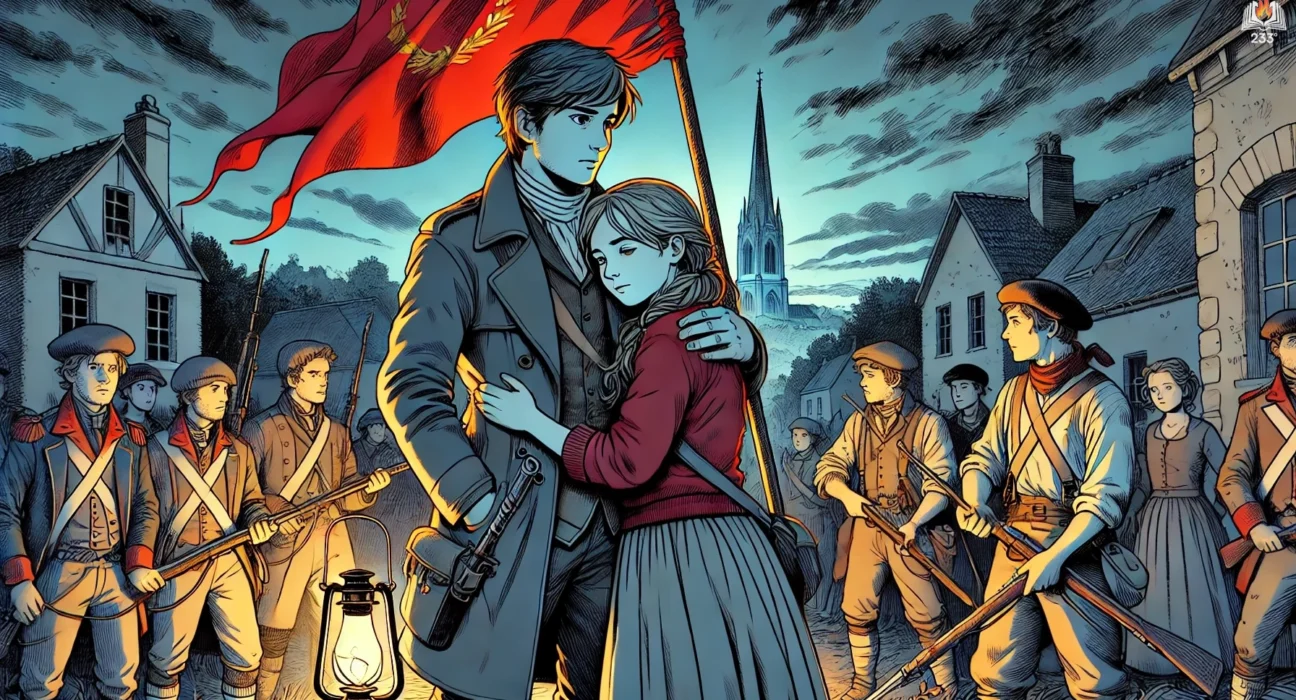The Fortune of the Rougons (1871) by Émile Zola is the first novel in the Rougon-Macquart series, which explores the lives and fortunes of a family across twenty volumes. Set during the early years of the Second Empire in France, the novel examines the origins of two branches of the Rougon-Macquart family, focusing on the political turmoil of 1851, specifically Louis-Napoléon Bonaparte’s coup d’état. Zola uses this story to introduce the main themes of heredity, class, and ambition that dominate the series. The novel intertwines personal drama and historical context, giving birth to characters that will have recurring roles in later novels.
Plot Summary
In the small town of Plassans, life pulses under a veil of simmering tensions, ambitions, and political unrest. The town, steeped in provincial quietude, will soon witness a series of events that will shape the fate of its most notable family, the Rougons, and those tied to them by blood and circumstance.
Pierre Rougon and his wife, Félicité, have long yearned for wealth and influence. Pierre, the eldest son of the modest Rougon family, carries the frustrations of an unremarkable life. His wife, sharp and ambitious, pushes him toward greatness, constantly scheming to elevate their status. But as the town of Plassans begins to stir with rumors of revolution and a coup d’état, the Rougons see an opportunity to finally seize the fortune and power they crave.
Meanwhile, at the heart of the impending conflict, Silvère Mouret, a young idealist and the son of Pierre’s half-brother, stands on the opposite side of the family’s ambitions. Silvère, raised in the care of his grandmother, Aunt Dide, embodies the spirit of Republicanism, an intense belief in liberty and the downfall of the Empire. His love for Miette, a passionate and fiery girl who shares his ideals, binds them both in a tender yet doomed romance. They meet under the shadow of night, clinging to each other as they prepare to join the Republican uprising, determined to fight for justice.
As Louis-Napoléon Bonaparte’s forces prepare for a coup, Plassans becomes a hotbed of intrigue. The town’s middle class, eager to preserve their fortunes, sides with the Empire, while the working class, including Silvère and his comrades, yearn for a Republic. Tension brews between the two sides, a division that threatens to tear apart the town—and the Rougon family.
Pierre and Félicité, determined to profit from the coming political chaos, plot their way into favor with the authorities. In secret, they side with the royalist forces and the Empire, knowing that should the Republicans succeed, their dreams of power will vanish. Pierre’s half-brother, Antoine Macquart, meanwhile, harbors deep resentment toward the Rougons. Born of an illegitimate branch of the family, Antoine’s life has been shaped by bitterness, poverty, and envy. Seeing the Rougons climb toward fortune stirs his rage, and he aligns himself with the Republicans, hoping to watch Pierre and Félicité’s ambitions crumble.
At the same time, Silvère and Miette’s love story unfolds amidst the turmoil. Their bond is fierce, filled with youthful innocence and dreams of a future beyond the Empire’s oppression. Together, they march with the Republican insurgents, clutching at the fragile hope of a better world. They dream of overthrowing the Empire and living freely, but the forces against them are vast, and the revolution’s success uncertain.
As the coup approaches, Pierre and Félicité grow increasingly anxious. They seek to align themselves with Roudier, a powerful man in Plassans, whose influence can sway the political tide in their favor. They court his favor with flattery and gifts, trying to ensure their place in the new order. Finally, the moment they have been waiting for arrives—the insurrection erupts, and chaos floods the town. With feverish determination, Pierre seizes control of the town hall, aligning himself with the Empire’s loyalists. His ambition is finally within reach.
While Pierre maneuvers through political waters, Silvère and Miette join the Republican forces outside Plassans. They fight with all the passion of youth, certain that their cause is just and righteous. The couple clings to each other in the darkness, filled with dreams of a life beyond the turmoil, but their ideals clash with the brutal reality of the Empire’s crushing military force. The Republicans, despite their fervor, are no match for the Empire’s soldiers.
The insurrection is quickly put down, and the Republican dream collapses. As soldiers march into Plassans to restore order, Silvère and Miette attempt to flee, but their youthful passion and defiance lead them to a tragic fate. Silvère is captured, and Miette, ever loyal to him, stays by his side as they face their doom together. They are executed, their love and lives extinguished in the wake of the Empire’s triumph.
Back in Plassans, Pierre and Félicité’s gamble pays off. With the Republican threat quashed and the Empire secure, they are rewarded for their loyalty. Pierre is appointed a lucrative position, ensuring the Rougon family’s rise to prominence. They bask in their newfound wealth and influence, their dreams of fortune finally realized. Yet, there is an undercurrent of unease in their triumph. The shadow of Silvère’s death, and the knowledge of their betrayal, lingers in the background, a reminder of the cost of their success.
In the final moments, Aunt Dide, the matriarch of the family, is left to mourn the loss of her grandson Silvère. Her sorrow, silent and deep, symbolizes the profound tragedy that has unfolded within the family. As Pierre and Félicité celebrate their victory, the Rougon-Macquart line is stained with blood and betrayal, setting the stage for future generations to grapple with the consequences of their ambition.
Their fortune has been secured, but at what cost? The Rougons may have risen to power, but the seeds of their future downfall have already been sown, ensuring that the family’s legacy will be one of both triumph and tragedy.
Main Characters
Pierre Rougon – The central character, Pierre is ambitious and cunning, eager to rise in society. He represents the greedy and opportunistic part of the Rougon family. Throughout the novel, he strives for power and wealth, willing to betray even his loved ones to achieve his goals.
Félicité Rougon – Pierre’s equally ambitious wife. She plays a vital role in pushing Pierre towards seizing political power. Sharp and manipulative, Félicité is a driving force behind the family’s rise and uses her intelligence to secure their fortune.
Silvère Mouret – A young idealist, Silvère represents the more virtuous side of the Rougon-Macquart family. He’s deeply involved in the Republican cause and fights against Louis-Napoléon’s coup. His innocence and devotion to his ideals contrast with Pierre’s selfishness.
Miette (Marie Chantegreil) – Silvère’s love interest, Miette is a young girl who, like Silvère, believes in the Republican cause. Her tragic love story with Silvère adds a layer of pathos to the political upheaval that surrounds them.
Antoine Macquart – Pierre’s half-brother, representing the illegitimate, disinherited branch of the family. Bitter and resentful, Antoine seeks to undermine Pierre’s success at every opportunity. His actions throughout the novel reflect his frustration with his lower social status.
Theme
Heredity and Social Determinism – A central theme in Zola’s Rougon-Macquart series, heredity plays a significant role in The Fortune of the Rougons. The novel explores how the traits and flaws of the Rougon-Macquart family members are passed down through generations. Zola, a pioneer of naturalism, emphasizes how their environment and ancestry shape their destinies.
Power and Corruption – Pierre and Félicité’s pursuit of wealth and power symbolizes the broader corruption in French society during the Second Empire. Zola critiques the moral decay that accompanies political ambition, portraying how personal greed intersects with historical events.
Political Upheaval – The backdrop of Louis-Napoléon Bonaparte’s coup d’état reflects the turmoil of the time. The novel captures the conflicting ideals of monarchy and republicanism, as personified by the Rougon and Macquart families. Zola uses this to explore the different ways people respond to change—some rise to power, others are crushed.
Love and Tragedy – The relationship between Silvère and Miette symbolizes youthful idealism and the personal costs of political conflict. Their romance, tragically cut short by violence, mirrors the destruction of hope during revolutionary struggles.
Writing Style and Tone
Zola’s writing in The Fortune of the Rougons reflects his commitment to naturalism, where he portrays characters and events with stark realism. His style is richly descriptive, bringing to life the provincial town of Plassans and the political upheaval that shakes it. The narrative voice is often detached, observing characters with a clinical eye, especially when delving into their motivations and flaws. This objectivity aligns with Zola’s scientific approach to literature, treating the family as a social and biological experiment.
The tone alternates between satirical and tragic. Zola mocks the selfishness and hypocrisy of the Rougons and other bourgeois characters, while simultaneously evoking sympathy for figures like Silvère and Miette. The contrast between ambition and innocence, greed and idealism, creates a multi-layered narrative that is both critical of society’s flaws and deeply human in its exploration of love and loss.
We hope this summary has sparked your interest and would appreciate you following Celsius 233 on social media:
There’s a treasure trove of other fascinating book summaries waiting for you. Check out our collection of stories that inspire, thrill, and provoke thought, just like this one by checking out the Book Shelf or the Library
Remember, while our summaries capture the essence, they can never replace the full experience of reading the book. If this summary intrigued you, consider diving into the complete story – buy the book and immerse yourself in the author’s original work.
If you want to request a book summary, click here.
When Saurabh is not working/watching football/reading books/traveling, you can reach him via Twitter/X, LinkedIn, or Threads
Restart reading!








